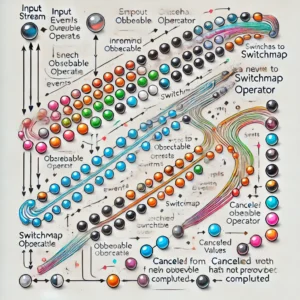JavaScript is a powerful scripting language that has become a cornerstone of modern web development. It allows developers to create interactive and dynamic websites that can respond to user input and update content in real-time. JavaScript is used to add functionality to web pages, from simple animations to complex applications that can run entirely in the browser.
One of the key roles of JavaScript in modern web development is its ability to make websites stateful. This means that JavaScript can keep track of changes to a website’s content and respond to user interactions accordingly. For example, JavaScript can be used to create an interactive form that updates its fields based on user input, or a real-time chat application that updates messages as they are sent and received.
JavaScript is also used to enable dynamic web development, allowing developers to create websites that can adapt to different screen sizes and resolutions. This is particularly important in today’s mobile-first world, where users are accessing websites on a wide range of devices, from smartphones to tablets and laptops. With JavaScript, developers can create responsive websites that look great and function well on any device.
Essentials of JavaScript
JavaScript is a popular programming language that has become an essential part of modern web development. This section will cover some of the key features and concepts that are important to understand when working with JavaScript.
Variables and Data Types
In JavaScript, variables are used to store data values. There are several different data types that can be stored in a variable, including strings, numbers, and booleans. Variables can be declared using the var, let, or const keywords, with const being used for values that will not change.
Functions
Functions are a fundamental part of JavaScript and are used to group together a set of instructions that can be called multiple times. Functions can take parameters, which are used to pass data to the function, and can also return values.
Objects and Arrays
JavaScript also supports objects and arrays, which are used to store collections of data. Objects are used to store key-value pairs, while arrays are used to store a list of values. Both objects and arrays can be nested, allowing for complex data structures to be created.
Control Flow Statements
Control flow statements are used to control the order in which statements are executed in a program. JavaScript supports several control flow statements, including if statements, for loops, and while loops.
DOM Manipulation
Finally, JavaScript is often used to manipulate the Document Object Model (DOM) of a web page. The DOM is a tree-like structure that represents the elements of a web page, and JavaScript can be used to add, remove, or modify elements of the DOM dynamically.
Overall, these are just a few of the essential concepts that are important to understand when working with JavaScript. By mastering these concepts, developers can create powerful and dynamic web applications that provide a great user experience.
JavaScript in Front-End Development
JavaScript is an essential component of modern web development. It enables developers to create dynamic and interactive web pages that engage users and provide a high-quality user experience. In this section, we will explore the role of JavaScript in front-end web development and its impact on the user experience of web applications.
Interactive Web Elements
Front-end developers use JavaScript (along with HTML and CSS) to create the parts of a web page that users see and interact with in their browsers. Before JavaScript, web pages only served static content. JavaScript gave developers the ability to provide their users with a dynamic web experience, adding animations and other interactive elements.
One of the most significant advantages of using JavaScript in front-end development is the ability to create interactive web elements. These elements can range from simple animations to complex user interfaces. JavaScript allows developers to create dynamic content and improve user experiences by enhancing web applications with interactivity and responsiveness.
Single Page Applications
Single Page Applications (SPAs) are web applications that load a single HTML page and dynamically update that page as the user interacts with the application. SPAs have become increasingly popular in recent years due to their ability to provide a seamless user experience. JavaScript plays a critical role in the development of SPAs, enabling developers to create dynamic and responsive user interfaces.
In SPAs, JavaScript is used to handle user interactions, update the page content, and communicate with the server. As a result, SPAs can provide a faster and more responsive user experience than traditional multi-page applications. With the help of JavaScript, developers can create SPAs that provide a high-quality user experience and meet the demands of modern web users.
Overall, JavaScript is an essential component of front-end web development. It enables developers to create dynamic and interactive web pages that engage users and provide a high-quality user experience. With the help of JavaScript, developers can create web applications that meet the demands of modern web users and provide a seamless user experience.
JavaScript in Back-End Development
JavaScript is no longer limited to front-end development. With the introduction of Node.js, JavaScript has become an essential part of back-end development. Node.js is a JavaScript runtime built on Chrome’s V8 JavaScript engine, which allows developers to write server-side applications in JavaScript.
Node.js
Node.js has become a popular choice for back-end development due to its scalability, performance, and ease of use. It has a vast library of modules that can be easily installed using npm (Node Package Manager), making it easy to add functionality to your application. Node.js also has a non-blocking I/O model, which means it can handle a large number of simultaneous connections without blocking the event loop.
One of the most significant benefits of using Node.js is the ability to use the same language on both the front-end and back-end. This means that developers can create a seamless experience for users, with faster load times and a more responsive interface.
API Creation
JavaScript is also widely used in creating APIs (Application Programming Interfaces). APIs are used to allow communication between different systems, and JavaScript is an excellent choice for creating them. With Node.js, developers can easily create RESTful APIs that can be used to access data and perform various operations.
JavaScript is also used to create APIs for popular web services such as Google Maps, Twitter, and Facebook. These APIs allow developers to integrate these services into their applications, providing users with a more comprehensive experience.
In conclusion, JavaScript has become an essential tool for back-end development with the introduction of Node.js. Its ease of use, scalability, and performance make it a popular choice for creating server-side applications and APIs.
JavaScript Frameworks and Libraries
JavaScript frameworks and libraries have become an essential part of modern web development. They provide developers with tried and tested tools for building scalable, interactive web applications. These tools are designed to make the development process faster, more efficient, and more manageable.
React.js
React.js is a popular JavaScript library developed by Facebook. It is widely used for building user interfaces and is known for its performance and scalability. React.js allows developers to build reusable UI components, which can be used across multiple pages. This makes it easy to maintain and update the codebase.
One of the key benefits of using React.js is its ability to handle large amounts of data without affecting performance. This is achieved through the use of a virtual DOM, which allows React.js to update only the necessary parts of the UI, rather than updating the entire page.
Vue.js
Vue.js is a progressive JavaScript framework that is gaining popularity among developers. It is designed to be easy to use and understand, making it a great choice for beginners. Vue.js provides developers with a range of tools for building scalable and maintainable web applications.
One of the key features of Vue.js is its reactivity system. This allows developers to create dynamic user interfaces that update in real-time as data changes. Vue.js also provides a range of tools for building reusable components, making it easy to maintain and update the codebase.
Angular.js
Angular.js is a powerful JavaScript framework developed by Google. It is widely used for building complex web applications and provides developers with a range of tools for building scalable and maintainable code.
One of the key benefits of using Angular.js is its ability to handle large amounts of data. This is achieved through the use of two-way data binding, which allows changes in the UI to be automatically reflected in the data model and vice versa. Angular.js also provides a range of tools for building reusable components, making it easy to maintain and update the codebase.
In summary, JavaScript frameworks and libraries provide developers with a range of tools for building scalable, interactive web applications. React.js, Vue.js, and Angular.js are just a few examples of the many frameworks and libraries available to developers. Each framework and library has its own strengths and weaknesses, so it is important to choose the one that best fits the needs of your project.
Testing and Debugging in JavaScript
JavaScript testing and debugging are crucial aspects of modern web development. They help ensure that code is functioning correctly and that errors are caught and resolved before they can cause issues for users. This section will discuss two important aspects of JavaScript testing and debugging: unit testing and debugging tools.
Unit Testing
Unit testing is a type of testing that focuses on testing individual functions or components of code. It involves writing small, automated tests that check that the code behaves as expected in different situations. Unit testing is an essential part of modern web development, as it helps catch errors early in the development process, making it easier and less costly to fix them.
There are several popular JavaScript unit testing frameworks, including Jest, Mocha, and Jasmine. These frameworks provide developers with tools for writing and running tests, as well as reporting on the results. They also often integrate with other development tools, such as code editors and continuous integration systems.
Unit testing can be challenging to set up and maintain, but it is an essential part of modern web development. By investing time and effort into unit testing, developers can ensure that their code is more reliable and less likely to cause issues for users.
Debugging Tools
Debugging is the process of identifying and fixing issues in code. JavaScript debugging can be challenging, as errors can be difficult to track down and resolve. Fortunately, there are many tools available to help developers debug their code.
One popular JavaScript debugging tool is the Chrome DevTools. DevTools is a set of web development tools built into the Google Chrome browser. It includes a debugger that allows developers to step through their code, set breakpoints, and inspect variables. DevTools also includes a console that allows developers to log messages and interact with their code in real-time.
Another popular debugging tool is Node.js. Node.js is a JavaScript runtime that allows developers to run JavaScript code outside of a web browser. It includes a debugger that allows developers to step through their code and inspect variables. Node.js also includes a REPL (Read-Evaluate-Print Loop) that allows developers to interact with their code in real-time.
In summary, JavaScript testing and debugging are crucial aspects of modern web development. By investing time and effort into unit testing and using debugging tools, developers can ensure that their code is more reliable and less likely to cause issues for users.
Performance Optimization in JavaScript
JavaScript is a powerful language that is widely used in modern web development. However, poorly optimized JavaScript code can cause performance issues that can negatively impact the user experience. Therefore, it is important to optimize JavaScript code to ensure that web applications are fast and responsive.
There are several techniques that can be used to optimize JavaScript performance. One of the most important techniques is to minimize the number of HTTP requests made by the web application. This can be achieved by combining multiple JavaScript files into a single file, reducing the size of the file, and using caching to reduce the number of requests made.
Another technique that can be used to optimize JavaScript performance is to reduce the amount of DOM manipulation. DOM manipulation can be slow, especially when dealing with large or complex web applications. Therefore, it is important to minimize the amount of DOM manipulation by using efficient algorithms and data structures.
In addition, developers can use tools such as profiling and debugging to identify performance bottlenecks in their JavaScript code. Profiling tools can help developers identify the parts of their code that are taking the most time to execute, while debugging tools can help identify and fix errors in the code.
Finally, it is important to keep up-to-date with the latest best practices and techniques for optimizing JavaScript performance. The JavaScript language is constantly evolving, and new techniques and tools are being developed all the time. By staying informed and up-to-date, developers can ensure that their web applications are fast, responsive, and provide a great user experience.
Future Trends in JavaScript
JavaScript has been around for over two decades and has evolved significantly over the years. As web development continues to expand and grow, JavaScript is expected to play an even more significant role in the future. Here are some of the expected trends in JavaScript that developers should keep an eye on:
Increased Use of AI and Machine Learning
JavaScript’s flexibility and versatility make it an excellent language for implementing AI and machine learning algorithms. With the increasing demand for AI-powered applications, JavaScript is expected to play a more significant role in the development of these applications.
Increased Use of Web Assembly
Web Assembly is a low-level bytecode format that is designed to run in modern web browsers. It is expected to play a more significant role in the future of JavaScript development. Web Assembly enables developers to write high-performance code in languages such as C++ and Rust, which can then be compiled to run in the browser.
Increased Use of Progressive Web Apps
Progressive Web Apps (PWAs) are web applications that can be installed on a user’s device and accessed through the browser. PWAs offer an app-like experience, with features such as push notifications, offline access, and home screen installation. JavaScript is expected to play a more significant role in the development of PWAs in the future.
Increased Use of Serverless Architecture
Serverless architecture is a cloud computing model in which the cloud provider manages the infrastructure and automatically allocates resources as needed. JavaScript is expected to play a more significant role in the development of serverless applications, as it is well-suited to the event-driven nature of serverless architecture.
Overall, JavaScript is expected to continue to play a vital role in the future of web development. Developers who stay up-to-date with the latest trends and advancements in JavaScript will be better equipped to develop high-performance, scalable, and secure web applications.
Conclusion
In conclusion, JavaScript plays an essential role in modern web development. It allows developers to create highly responsive interfaces that improve the user experience and provide dynamic functionality, without having to wait for the server to react and show another page.
JavaScript can load content into the document if and when the user needs it, without reloading the entire page. This is commonly referred to as Ajax, and it has become a standard technique in modern web development.
Moreover, JavaScript is a scripting or programming language that allows developers to implement complex features on web pages. Every time a web page does more than just sit there and display static information, you can bet that JavaScript is behind it.
Overall, JavaScript has evolved tremendously since its inception in 1995. It is now a powerful language that can be used to build complex web applications and interactive user interfaces. As such, it is an essential skill for any modern web developer to master.






